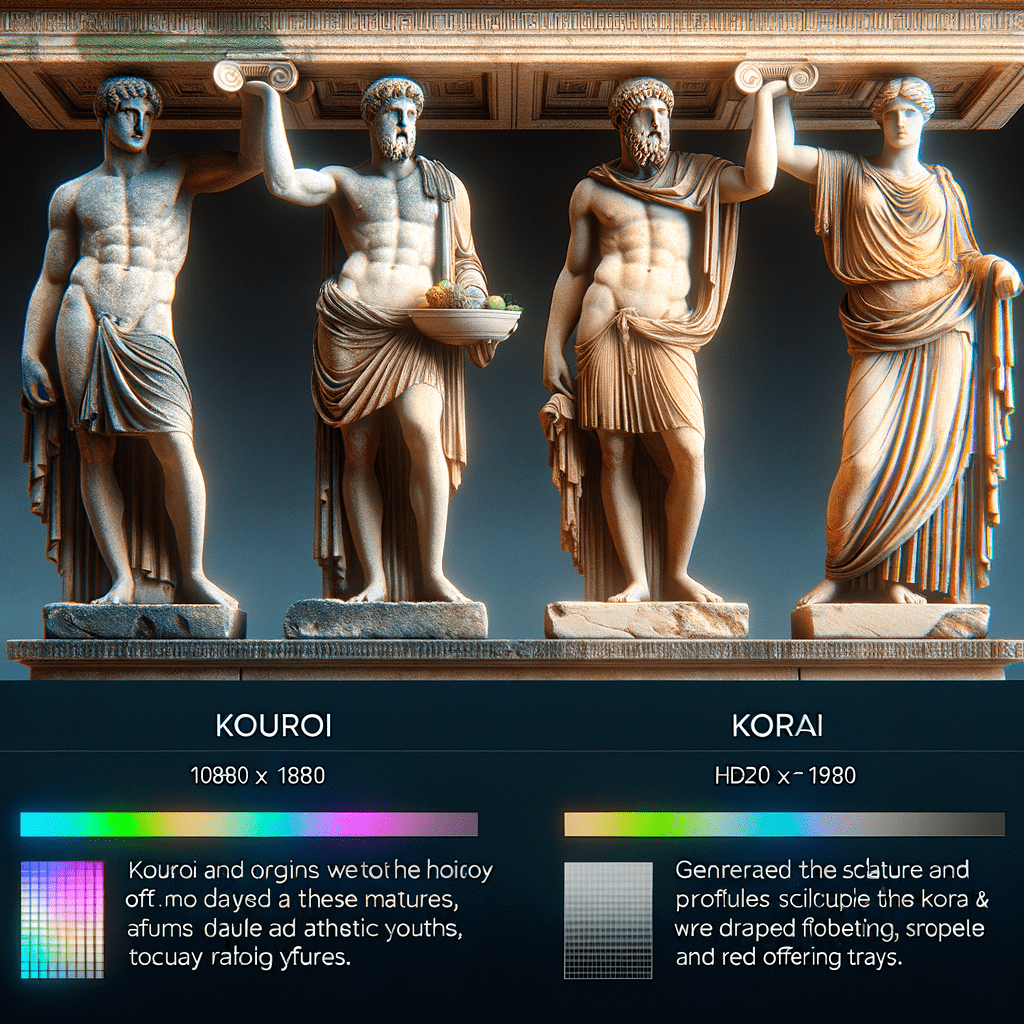Kouroi and Korai: Emblems of Culture and Aesthetics in Ancient Greek Art
In the vast landscape of ancient Greek art, the Kouroi and Korai represent two of the most emblematic and fascinating sculptural forms. These statues, depicting young men and women, offer a unique glimpse into the culture, religion, and aesthetics of ancient Greece.
In this article, we will explore the origins, history, and differences between the Kouroi and Korai, providing concrete examples and detailed analysis.
- Origins of the Kouroi and Korai
- History and Development
- Differences between Kouroi and Korai
- Famous Examples
- Conclusion
Origins of the Kouroi and Korai
The statues of Kouroi and Korai originated in ancient Greece, dating back to the Archaic period (circa 700-480 BCE). These sculptures were often used as votive offerings in sanctuaries or as funerary markers. The Kouroi, representing naked young men, and the Korai, depicting clothed young women, were influenced by Egyptian sculptures but gradually developed unique characteristics that reflect Greek values and beliefs.
History and Development
The production of Kouroi and Korai evolved over the centuries, reflecting changes in Greek society and art. During the archaic period, the statues were characterized by a formal rigidity and an archaic smile, a fixed expression that suggested vitality and divinity. As time went on, the sculptures became more realistic and detailed, showing a greater understanding of human anatomy and movement.
The Archaic Period
In the Archaic period, the Kouroi and Korai were often carved in marble and displayed a frontal and rigid posture. The male figures were depicted nude, with closed fists and arms at their sides, while the female figures were dressed in elaborate garments and often held an offering or symbolic object.
The Classical Period
With the advent of the Classical period (circa 480-323 BCE), Greek sculptures became more natural and dynamic. The Kouroi and Korai of this period show greater attention to anatomical details and a more realistic representation of the human body. The poses became more relaxed and natural, reflecting a change in the perception of beauty and art.
Differences Between Kouroi and Korai
Despite the similarities, there are several key differences between the Kouroi and the Korai that reflect the distinctions in gender and roles in ancient Greek society.
- Gender Representation: The Kouroi depict young naked men, symbolizing male strength and beauty, while the Korai portray young women dressed in elaborate garments that often indicate their social status.
- Function: Kouroi were often used as funerary markers or votive offerings, while Korai were primarily votive offerings in sanctuaries.
- Style and posture: The Kouroi exhibit a frontal and rigid posture, with clenched fists and arms at their sides, while the Korai are depicted in more relaxed and natural poses, often with one arm raised to hold an offering.
Famous Examples
Some of the most famous Kouroi and Korai offer a fascinating glimpse into the artistic mastery and cultural beliefs of ancient Greece.
Anavyssos Kouros
The Kouros of Anavyssos, dating back to 530 B.C., is one of the most renowned examples of archaic sculpture. This statue depicts a young naked man in a frontal and rigid posture, with an archaic smile that suggests vitality and divinity.
Peplos Kore
The Peplos Kore, dating back to 530 B.C., is one of the most famous Korai. This statue portrays a young woman dressed in a peplos, a traditional Greek garment, and exhibits a greater attention to detail and a more realistic representation of the human body.
Conclusion
The Kouroi and Korai represent two of the most emblematic sculptural forms of ancient Greece, offering a unique glimpse into the culture, religion, and aesthetics of this civilization. Through the analysis of their origins, history, and differences, we can appreciate the artistic mastery and cultural beliefs that shaped these fascinating works of art.
For further reading, the following resources are recommended:
- Encyclopaedia Britannica – Greek Art
- The Metropolitan Museum of Art – Archaic Greek Art
- Khan Academy – Ancient Greek Art




